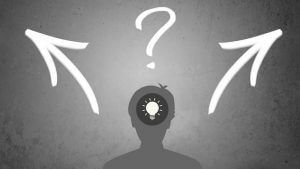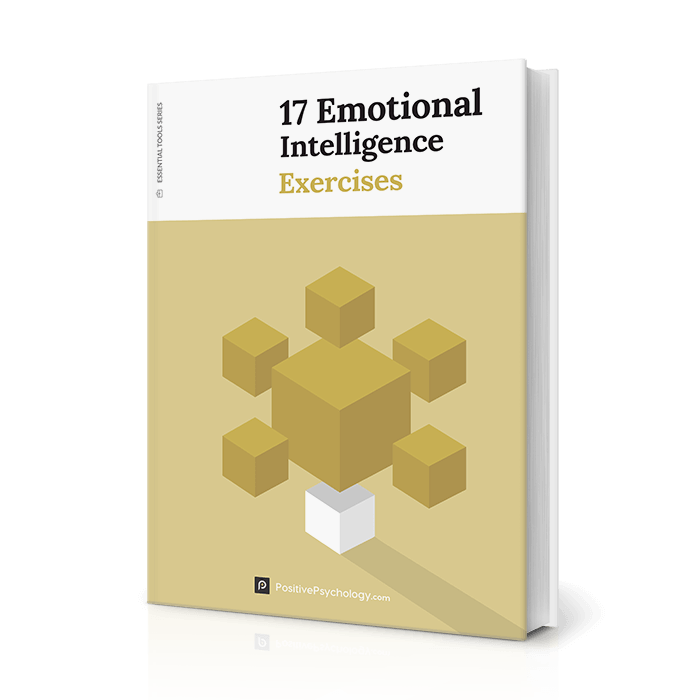What Is Positive and Negative Affect? Definitions + Scale
 The difference between “affect” and “effect” is hard enough for a lot of us to grasp.
The difference between “affect” and “effect” is hard enough for a lot of us to grasp.
Which is which, again? Do I have an affect or an effect on my spouse? Does my spelling affect my grade or effect my grade?
Keeping track of these two different versions can prove challenging already, but you may have seen the third version of this word that actually refers to a completely different idea—now you have another “affect” to add to your vocabulary!
(By the way, I have an effect on my spouse and my spelling affects my grade— the “e” spelling is for the noun and the “a” spelling is for the verb).
However, there’s an easy way to keep them apart: the pronunciation will help! While the first two versions are usually pronounced the same (something like “uh-fekt” or “eh-fekt”), the third version is pronounced with emphasis on the first syllable. “Affect” in this context is pronounced with the “a” as it is pronounced in “apple.”
Now that we’ve had our grammar lesson (I apologize if you fell asleep), we can move on to the really important part: figuring out what this third version of the word refers to.
Before you read on, we thought you might like to download our three Emotional Intelligence Exercises for free. These science-based exercises will not only enhance your ability to understand and work with your emotions but will also give you the tools to foster the emotional intelligence of your clients, students or employees.
This Article Contains:
- What is Positive and Negative Affect?
- The Psychology of Positive and Negative Affectivity
- Positive and Negative Affect Schedule – The PANAS Scales
- Other Scales, Tests, and Questionnaires
- How Positive and Negative Affect Impact Health
- Positive Affectivity and Surgency
- Positive Affectivity and Anxiety
- Positive Affect and Decision-Making
- Positive Affect and Creative Problem Solving
- A Look at Low Positive Affect
- What is Positive Affect Tolerance?
- Negative Affect Reciprocity
- Negative Affect Syndrome
- Negative Affectivity in the Workplace
- Are There Benefits to Negative Affect?
- A Take-Home Message
- References
What is Positive and Negative Affect?
The word “affect” is basically a more technical way to talk about emotion and expression. It refers to the emotions or feelings that we experience and display, especially in terms of how these emotions influence us to act and make decisions.
Positive affectivity refers to positive emotions and expression, including cheerfulness, pride, enthusiasm, energy, and joy. Negative affectivity is negative emotions and expression, which includes sadness, disgust, lethargy, fear, and distress.
Positive and negative affectivity not only plays a large role in our day-to-day experience and our enjoyment, our affectivity can also influence our opinions, thoughts, performance, abilities, and even our brain activity!
Positive Affect vs. Negative Affect
People often assume that positive and negative affect are on two opposite ends of a bipolar scale. You can only be at one point on this scale, meaning you can be experiencing one type of affect to a certain degree (from extremely mild to extremely strong), but not the other at the same time.
Give that idea a little bit of thought. Have you ever felt good and bad emotions at the same time? Perhaps when you see a friend accomplishing something you have yet to accomplish, or when an ex that you split on good terms with finds happiness with someone else?
I’m willing to bet you can think of at least one or two scenarios in which you have experienced both positive and negative affectivity at the same time. The ability to experience both at the same time means that the bipolar model of positive and negative affectivity is inaccurate; you do not need to be at only one point on the spectrum, since there are two spectrums to consider—one for positive affect and one for negative.
This idea is backed up by research. When researchers compared the level of positive affect experienced to the level of negative affect experienced, they found an interesting phenomenon: dispositional (or trait-level) positive and negative affect are unrelated, but state-level positive and negative affect are negatively related (Schmukle, Egloff, & Burns, 2002).
This means that the general level of positive affect that a person experiences is not related to the level of negative affect they experience, and vice versa. In the moment, people generally tend towards one or the other, but overall positive and negative affect tend to vary completely independently.
10 Examples of Positive and Negative Affect
It’s easy to understand positive and negative affectivity on an intuitive level, but just to clarify what we mean when we talk about these two types of affect, check out these examples.
Positive affect:
- Joy
- Contentment
- Interest
- Engagement
- Pride
Negative affect:
- Anger
- Fear
- Anxiety
- Sadness
- Depression
The Psychology of Positive and Negative Affectivity
Traditionally, positive affectivity hasn’t received as much attention as negative affectivity in the literature. It wasn’t until the latter half of the 20th century that researchers started showing significant interest in this concept.
The first major theoretical breakthrough was in 1975, with Paul Meehl’s publication exploring the concept of “hedonic capacity.” Meehl believed that hedonic capacity, or ability to experience pleasure, is different for each and every one of us.
Meehl also proposed that hedonic capacity is distinct from individual differences in negative emotionality, a proposal that upended the old idea of positive and negative affectivity living on the same scale.
So, with this enhanced interest in affectivity, what have we learned from all the research? Quite a lot!
Characteristics and Personality Traits of PA and NA
As you probably expect, research has shown that positive affectivity is related to a person’s “orientation to happiness.” Those who are high in positive affectivity are more likely to search for happiness in a life of meaning and pleasure than those who are not; however, it’s interesting to note that negative affectivity is not correlated with orientation to happiness (Bhutoria & Hooja, 2018).
This means that a person with high positive affectivity is likely to find happiness through the experience of meaning and pleasure, but their level of negative affectivity is unrelated to the way that they experience or pursue happiness.
Further research has explored the relationship between positive and negative affectivity and personality traits. Positive affect is—predictably—negatively correlated with neuroticism. PA is also positively correlated to extraversion, openness to experience, agreeableness, and conscientiousness (Işık & Üzbe, 2015). On the other hand, negative affect is strongly, positively correlated with neuroticism but negatively correlated with the other personality traits (Işık & Üzbe, 2015; Zanon, Bastianello, Pacico, & Hutz, 2013).
These findings indicate that the more open, friendly, responsible, and outgoing a person is, the more likely they are to experience high positive affect and low negative affect. By the same token, those who lack emotional stability and self-esteem are more likely to experience negative affect and less likely to be high in positive affect.
What Factors Most Influence Positive and Negative Affectivity?
Now that we have an idea of what positive and negative affectivity are linked to, let’s answer the next logical question: what factors MOST influence positive and negative affectivity?
As we noted above, neuroticism is a strong predictor of both positive and negative affect. Given what we know about neuroticism, this makes sense; those who are less emotionally stable and more “moody” are generally experiencing more negative affect and less positive affect than people who are generally on an even keel.
Positive and Negative Affect Schedule – The PANAS Scales
The Positive and Negative Affect Schedule, or PANAS for short, was developed to measure both positive and negative affect in individuals. Since its inception in 1988 (Watson, Clark, & Tellegen), it has been one of the most widely used scales in psychology, and is particularly popular in positive psychology.
The scales are composed of 20 moods or affective states scored on a scale from 1 (very slightly or not at all) to 5 (extremely). These affective states include generally positive states like excited, enthusiastic, and inspired, along with generally negative states like distressed, guilty, and irritable.
The instructions are to rate either how you are feeling in the present moment or how you’ve felt over the past week, which can provide two different measures of positive and negative affect in the same person. There are research purposes for both types of measures, but it’s important to carefully consider what measure you need when planning to use the PANAS. A person’s current mood and their mood over the last week can be very different!
To score the PANAS, simply add up the ratings for each of the positive and negative items. Both positive and negative affect can range anywhere from 10 to 50, with higher scores indicating higher experience of that type of affect. For a general baseline, you can refer to the mean scores reported by the developers of the PANAS:
- Positive Affect (Momentary): 29.7
- Positive Affect (Weekly): 33.3
- Negative Affect (Momentary): 14.8
- Negative Affect (Weekly): 17.4
Other Scales, Tests, and Questionnaires
In general, there are two basic types of measures of positive affectivity: those in which respondents rate their average feelings, and those which assess multi-trait personality. The first type is the more popular, with many scales available for measuring affectivity as well as some of the most popular scales (e.g., the PANAS). Two other example scales of this type are the Differential Emotions Scales (DES) and the Multiple Affect Adjective Checklist – Revised (MAACL-R).
The DES assesses the respondent’s level of ten different emotions during a particular experience (or in the current moment). The ten emotions are:
- Joy
- Surprise
- Anger
- Disgust
- Contempt
- Shame
- Guilt
- Fear
- Interest
- Sadness (Izard, Dougherty, Bloxom, & Kotsch, 1974)
The scale includes 30 adjectives (three per emotion) rated on a scale from 1 (never) to 5 (very often). Although it does not provide a single measure of positive affect and a single measure of negative affect, it’s easy to take a look at the 10 emotions and determine which emotions belong in which category.
Another option for self-reported positive and negative affect is the MAACL-R; this scale measures positive and negative affectivity as either a trait (General Form) or a state (Today Form). There are five subscales in the MAACL-R: positive affect, sensation seeking, hostility, depression, and anxiety. This 132 mood-related adjective check list is only available through purchasing the scale, which you can find here (Lubin & Zuckerman, 1999).
The other type of measuring positive affectivity is to assess multi-trait personality. Examples of this type are the Activity and Positive Emotions facet scales of the Revised NEO Personality Inventory and the Wellbeing scale of the Multidimensional Personality Questionnaire. Although not used as often, these scales can also be useful in research projects. To learn more about the MPQ click here.
PANAS scale – EPM
How Positive and Negative Affect Impact Health
Positive affectivity has many benefits for our everyday life. Happiness and positive emotions researcher Dr. Barbara Fredrickson has theorized that positive affectivity can broaden an individual’s momentary thought–action repertoire; in other words, positive affect encourages people to be more open, engaged, and willing to be creative.
For example, when a person is happy, they will likely experience a stronger urge to engage with others and try new things than when they are feeling negative or neutral.
This theory is called the “Broaden-and-Build” Theory of positive emotions, and it states the following:
- When we feel negative emotions like fear, sadness, and anxiety, we are more likely to narrow our thoughts and the options we consider for our next move.
- When we feel positive emotions like joy, inspiration, and engagement, we are more likely to broaden our thoughts and the options we consider for our next move.
- This broadening allows us to build up our resources, skills, and knowledge (Fredrickson, 2001).
These resources are generally categorized into one of three groups:
- Physical resources: energy, stamina, fitness, health, overall wellness, etc.
- Psychological resources: ability to choose to be more optimistic, ability to pull yourself out of rumination, ability to withstand hectic schedules without experiencing burnout, etc.
- Social resources: supportive friendships, friends who are there for you, neighbors who look out for you, and healthy, fulfilling romantic relationships (Scott, 2018).
To get a better handle on this, let’s think of an example for each scenario.
Imagine a man is confronted by a prowling predator. Would it be better for him to feel contentment or terror? Most likely, he will be better off feeling terror.
If he feels contentment, he might simply stroll away from the predator, thinking happy thoughts, and pay little heed to what the predator is doing. If he feels terror, he will probably not be experiencing happy thoughts, but will instead be laser-focused on what he can do to survive this dangerous situation. Feeling terror is associated with a much better outcome than feeling contentment in this scenario.
On the other hand, imagine a competent professional is networking at an event with lots of smart, important people in her line of work. Would it be better for her to feel confident and outgoing or fearful?
As with the first example, the correct answer is obvious: it is better for her to experience confidence and sociability than fear. If she is outgoing and confident in herself, she will probably meet more people and present herself as more competent and friendly, making valuable new connections that she can use later on.
If she is fearful and nervous about being at the event, she will probably not reach out and make many new connections, and she may come off as unfriendly, incompetent, or just plain weird!
Fredrickson’s theory says that both positive and negative emotions have evolutionary advantages; negative emotions encourage people to survive in life-or-death situations, but positive emotions encourage us to develop our skills and build new resources.
In the examples above, the man is more likely to walk away from the predator unharmed when he is experiencing negative affect, but the networking professional is developing her communication and networking skills, building up resources by making connections, and generally improving herself and her abilities.
Fredrickson based some of her theory on previous findings from affectivity researcher Alice Isen. Isen (1987) conducted a study to investigate how positive emotions can affect cognition, and she found that experiences of positive affect can enlarge cognitive context and influence creative thinking.
In plain English, this means that feeling positive emotions makes people more likely to be flexible and to think more expansively when organizing and referencing information and ideas.
In addition to providing evolutionary advantages, improving skills, and enhancing resources, positive emotions also have more direct effects on our health and wellbeing.
Positive affect has been linked to less stress, optimism, extraversion, happiness, and success in general (Scott, 2018).
Before we move on, check out this short list of ways you can improve your positive affectivity and reap the benefits listed above:
- Maintain a gratitude journal: write about what you are grateful for and you will subsequently feel even more grateful and happy.
- Indulge in the good things in life: incorporate pleasurable experiences into your life to experience positive affect more often.
- Engage in hobbies you like: getting into the flow of your favorite hobbies can leave you with more positive emotions, less stress, and a sense of accomplishment and fulfillment.
- Practice loving-kindness meditation: this type of meditation is a great way to boost your joy and beat back stress.
- Exercise in a way you enjoy: we all know that being active is linked to health, but it’s important to make sure that the physical activity you engage in is something you enjoy.
- Savor the positive: think back on your positive memories and good times you’ve experienced as often as you can (Scott, 2018).
Although more positive affect isn’t always a good thing, you probably don’t have to worry about overdoing it—so give all these strategies a try!
How PA and NA Affect the Brain
Positive and negative affect are both influenced by and influencers of what goes on in the brain. Our brain is what determines what is positive and potentially beneficial (provoking positive affect) and what is negative and potentially harmful (provoking negative affect), but there is a feedback loop in which positive and negative affect also influence brain activity.
For example, a study utilizing an EEG to measure electrical activity in the brain found that not people high in negative affectivity underperform in a spatial task compared to those high in positive affectivity (Bell & Fox, 2003). This difference in performance may be explained by the differences in brain activation: those high in negative affectivity don’t experience enhanced activation in the parietal lobe during the spatial task, which those high in positive affectivity do experience.
Without getting into too much detail, it seems that there is a strong feedback loop between brain activity and affectivity, such that positive affectivity suppresses and enhances activation in different areas than negative affectivity.
Positive Affectivity and Surgency
Surgency is the tendency to experience and display high levels of positive affect. This term is most often used in developmental work to refer to child temperament, but it can apply to adults as well. It is associated with high activity, lack of shyness, and social dominance, and those high in surgency can be said to be
“energetic, sociable, positive, and outgoing, and enjoy exciting or intense activities”
(Holmboe, 2016, p. 1).
As you can probably tell from the description, surgency is related to extraversion—those high in surgency also score high on the Big Five dimension of extraversion. You might think surgency is related to agreeableness as well, but not necessarily; people high in surgency may be outgoing and social, but they can easily dominate a conversation and are less likely to “go with the flow.”
This concept of surgency is one example of how positive affect can have its downsides. It’s great to be happy, friendly, and outgoing, but you might find it difficult to make good friends if you are dominating conversations with your cheerfulness and energy!
Positive Affectivity and Anxiety
While low positive affectivity is a strong indicator of depression (barring other possible explanations like temporary sadness from grief, side effect of a medication, etc.), it turns out that positive affectivity is not a good predictor of anxiety issues.
Both depression and anxiety are characterized by higher than average negative affectivity, but positive affectivity is only related to depression (less positive affectivity is related to higher depression), meaning that anxiety is not necessarily caused by or a cause of low positive affect (Watson, Clark, & Carey, 1988).
However, positive affectivity and anxiety may be related in a different way; people with anxiety disorders tend to regulate their response to positive affect differently than those without. Anxious people more often “down-regulate” their positive emotions, meaning they use strategies to diminish, reduce, or suppress positive emotions (Eisner, Johnson, & Carver, 2009).
There are many reasons for this—it may be done to avoid what the person feels is inappropriate positive emotions in public, or it may be done because the individual is uncomfortable with any strong emotions. Finding ways to more fully engage with and enjoy positive emotions is a great goal for people struggling with anxiety.
Positive Affect and Decision-Making

However, there is a caveat to this finding: research indicates that positive affect only improves decision-making when the task is “one that is meaningful, interesting, or important to the decision-maker” (Isen, 2001, p. 78).
High positive affect groups completing a group task reached a decision sooner, displayed less redundancy in the task process, and were able to eliminate the low-importance factors from consideration.
These benefits of positive affect during decision-making come from an enhanced ability to integrate material for decision-making and less confusion when faced with a lot of information, which allow decision-makers to work faster and finish earlier or move on to other important considerations. In general, those who are experiencing positive affect are more flexible, open, and innovative, but are also simultaneously more careful and thorough in addressing important considerations (Isen, 2001).
Positive Affect and Creative Problem Solving
As noted above, positive affect can help improve the efficiency of decision-making and problem-solving. One of the reasons why positive affect improves problem-solving efficiency is the boost to creativity that positive emotions can bring.
Participants who were presented with a small bag of candy or a few minutes of a comedy film outperformed the other groups (two that exercised and one that experienced negative affect) in two creative problem-solving tasks (Isen, Daubman, & Nowicki, 1987).
Similar findings were found in a study of physicians; those who experienced a boost in positive affect scored better on a creativity task and even reported different sources of satisfaction gained through their work (Estrada, Isen, & Young, 1994).
Researchers believe this effect occurs because we are more likely to combine material in new ways and to note similarities between different stimuli when we are experiencing positive affect.
A Look at Low Positive Affect
Low positive affect can be a big problem, especially in children. When young children are low in positive affect and high in behavioral inhibition—two traits that often go hand-in-hand—they are less likely to approach and engage (Laptook, Klein, Durbin, Hayden, Olino, & Carlson, 2008). This effect is strong in novel situations, which are the situations in which you want children to approach and engage.
When children approach new objects and people and try new things, they learn.
This makes low positive affect a potentially huge detriment to children; of course, it’s not good for adults to be low in positive affect and to avoid more than they approach, but it can set children up for a lifetime of less open-mindedness, less calculated risk-taking, and more isolation. Low positive affect in children is something that any parent would do well to address when they notice it.
On the other hand, too much positive affect can also have negative effects in some situations.
What is Positive Affect Tolerance?
“Positive Affect Tolerance” might sound like an odd term—after all, who would need “tolerance” of positive affect?
Unfortunately, there are many people out there who may find it difficult or uncomfortable to feel positive affect. Many of these people are survivors of emotional neglect or even overt abuse in their childhood. Positive Affect Tolerance, or PAT, is a method of helping these people learn how to tolerate and integrate positive emotions and events into a shared positive experience of self (Leeds, 2007).
One example of an exercise in PAT is what to do when you are actively receiving appreciation, compliments, or praise:
- Make and maintain eye contact.
- Take a deeper breath into the upper chest to expand a space around the heart and make room for positive feelings.
- While maintaining eye contact say, “Thank you. I appreciate you saying that.”
Exercises like these can help people with a history of abuse become more accepting of positive states and more comfortable with feeling positive emotions.
Negative Affect Reciprocity
Do you have a sibling? If not, do you have two or more children? If so, you’ve likely seen a mild form of negative affect reciprocity.
Negative affect reciprocity, which is also sometimes called “reciprocation of negativity” or “mutual escalation,” is defined as the tendency for one person’s negative behavior to instigate or encourage another person’s negative behavior (Manusov, n.d.). For example, negative affect reciprocity (or NAR) is what happens one child misbehaves or acts in an unkind way toward his sibling, which prompts his sibling to lash out with bad behavior of her own.
This phenomenon is certainly not limited to children though; adults in romantic relationships can also be affected by NAR. It can be as subtle as one partner displaying negative emotions whenever the other one displays negative emotions, or as disastrous as one partner’s infidelity provoking the other partner into cheating as well.
Reciprocity is often mentioned in terms of repaying a favor or “paying forward” something good that someone did for you, but keep in mind that reciprocity can easily work the other way as well.
Negative Affect Syndrome
Negative Affect Syndrome or NAS is a general psychological state involving negative moods and emotions that are so intense they disrupt or impair normal functioning and adversely impact wellbeing (Henriques, 2013).
This general categorization is purposely broad and acts as a simpler alternative to the ever-increasing complexity and specificity of the Diagnostic and Statistical Manual. It is based on what we know about how the human brain and nervous system work; on a general level, one of the brain’s primary jobs is to figure out the costs and benefits. Costs are things that you want to avoid, while benefits are things that you want to approach.
NAS happens when the brain is unable to find an effective ratio of costs and benefits (i.e., the person cannot get their needs met), and results in suffering for the individual. NAS can cause feelings of melancholy, hopelessness, anxiety, nervousness, and many other negative moods and emotions.
There are arguments both for and against moving to a simpler categorization of negative affect, but it may be beneficial to at least have a broad categorization that highlights the similarities between the different diagnoses of depression and anxiety.
Negative Affectivity in the Workplace
Although too much negative affectivity can be detrimental no matter where or when it is experienced or displayed, it can be especially detrimental in the workplace.
Part of the reason why it has more destructive potential in the workplace is that people are generally in close quarters and working closely together.
This allows greater opportunity for collaboration, innovation, and teamwork, but it can also act as an opportunity for negativity to simmer and spread.
Early work on this topic showed that people who are high in negative affectivity are more likely to see themselves as victims of their coworkers’ aggression, especially if they were in a “low-status” position (Aquino, Grover, Bradfield, & Allen, 1999). It’s easy to see how aggression (perceived or actual) combined with high negative affectivity can poison a workplace!
The potential outcomes of high negative affectivity in the workplace can be devastating to an organization. High negative affectivity is related to workplace deviance, including behaviors like absenteeism, employee theft, lower productivity, and reduce organizational performance (Chen, Chen, & Liu, 2013).
Negative Affectivity in Management
As you can imagine, the negative outcomes associated with too much negative affectivity at work can be amplified when the NA is displayed in management.
According to the Leader-Member Exchange theory, leaders tend to form relationships of differing quality with their subordinates rather than relationships of similar quality across all their leader-member relationships (Tse, Ashkanasy, & Dasborough, 2012). When negative affectivity is brought into the picture, everyone suffers.
Negative affectivity in leader-member relationships can make the subordinates less likely to identify with their team or unit and negatively impact their job performance. Further, negative affect in supervisors is related to supervisor abuse of their subordinates and indirectly related to higher negative affect, lower job satisfaction, and fewer personal initiatives in employees (Pan & Lin, 2018).
While it’s important to make sure that the employees you hire or work with aren’t overly negative, it’s much more important to ensure that the managers you hire or work for are low in negative affectivity. The potential for negative outcomes is simply too great with managers who are high in NA.
However, don’t discount anyone who shows any negative affect—read on to find out why.
Are There Benefits to Negative Affect?
While too much negative affect is definitely a bad thing, low levels of negative affect can actually be a good thing.
According to a group of Japanese undergraduates, there are two major categories of benefits of NA:
- Benefits to the Self
- Benefits to Interpersonal Relations (Sakamoto et al., 2006)
Benefits to the self include things like self-inspection (which can lead to self-acceptance and self-expression), increased desire to improve oneself, the mental growth that can result from overcoming negative thinking, or increased creativity.
Benefits to interpersonal relations can be found in the form of increased understanding of others and the world (which can lead to better relationships) and more effective self-presentation (e.g., getting help from others when you’re down).
It never feels good to feel down, but that doesn’t mean it doesn’t have its uses!
More recent research has found that negative affectivity can improve memory, reduce judgment errors, and improve communications by changing up one’s cognitive processing style (Forgas, 2014). Further, being in a bad mood can also increase perseverance, effort exerted, and motivation to succeed.
Finally, negative moods can also make you more likely to deal fairly with others and better at persuading others (Forgas, 2014).
That’s a lot of potential benefits to something that seems like nothing but a bummer!
A Take-Home Message
This piece defined affect, differentiated between positive and negative affect, provided examples of each, and made a deeper dive into the literature on how positive and negative affect influence us and are influenced by us.
My hope is that you found the time you spent on this piece worthwhile and helpful in improving your understanding of this topic. If you take only one thing away from this piece, let it be this: positive and negative affect are not necessarily linked, and it is possible to increase your level of positive affect. If you struggle with low positive affect or high negative affect that interrupts or intrudes on your life, there is hope!
To learn more about positive and negative affect, take a quick peek at the literature by typing “positive and negative affectivity” into the Google Scholar search bar. To cement your understanding of affect and keep up on new research in this area, make sure to pay attention to pieces by the big names in the field: Watson, Clark, Tellegen, Fredrickson, and Isen.
What are your thoughts on positive and negative affectivity? Have you experienced abnormally high or low affectivity of either kind? Have you treated abnormally high or low affectivity? Do you think the PANAS is still a good way to measure affectivity? Let us know in the comments!
Thanks for reading!
We hope you enjoyed reading this article. Don’t forget to download our three Emotional Intelligence Exercises for free.
- Aquino, K., Grover, S. L., Bradfield, M., & Allen, D. G. (1999). The effects of negative affectivity, hierarchical status, and self-determination on workplace victimization. Academy of Management Journal, 42, 260-272.
- Bell, M. A., & Fox, N. A. (2003). Cognition and affective style: Individual differences in brain electrical activity during spatial and verbal tasks. Brain Cognition, 53, 441-451.
- Bhutoria, K., & Hooja, H. (2018). Role of positive affect and negative affect in orientation to happiness: A study on working population. Indian Journal of Health and Well-being, 9, 76-82.
- Chen, C., Chen, M. Y., & Liu, Y. (2013). Negative affectivity and workplace deviance: The moderating role of ethical climate. The International Journal of Human Resource Management, 24, 2894-2910.
- Eisner, L. R., Johnson, S. L., & Carver, C. S. (2009). Positive affect regulation in anxiety disorders. Journal of Anxiety Disorders, 23, 645-649.
- Estrada, C. A., Isen, A. M., & Young, M. J. (1994). Positive affect improves creative problem solving and influences reported source of practice satisfaction in physicians. Motivation and Emotion, 18, 285-299.
- Forgas, J. P. (2014). Can sadness be good for you? On the cognitive, motivational, and interpersonal benefits of negative affect. In W. G. Parrott’s (Ed.) The Positive Side of Negative Emotions, pp. 3-36. New York, NY, US: Guilford Publications.
- Fredrickson, B. L. (2001). The role of positive emotions in positive psychology: The broaden-and-build theory of positive emotions. American Psychologist, 56, 218-226.
- Henriques, G. (2013). Negative affect syndrome. Psychology Today. Retrieved from https://www.psychologytoday.com/us/blog/theory-knowledge/201308/negative-affect-syndrome
- Holmboe, K. (2016). Surgency. In V. Zeigler-Hill & T. K. Shackelford (Eds.), Encyclopedia of Personality and Individual Differences.
- Isen, A. M. (1987). Positive affect, cognitive processes, and social behavior. In L. Berkowitz (Ed.), Advances in Experimental Social Psychology Volume 20, pp. 203-253. San Diego, CA, US: Academic Press.
- Isen, A. M. (2001). An influence of positive affect on decision making in complex situations: Theoretical issues with practical implications. Journal of Consumer Psychology, 11, 75-85.
- Isen, A. M., Daubman, K. A., & Nowicki, G. P. (1987). Positive affect facilitates creative problem solving. Journal of Personality and Social Psychology, 52, 1122-1131.
- Işık, Ş, & Üzbe, N. (2015). Personality traits and positive/negative affects: An analysis of meaning in life among adults. Educational Sciences: Theory & Practice, 15.
- Izard, C. E., Dougherty, F. E., Bloxom, B. M., & Kotsch, N. E. (1974). The Differential Emotions Scale: A method of measuring the subjective experience of discrete emotions. Nashville, TN, US: Vanderbilt University Press.
- Laptook, R. S., Klein, D. N., Durbin, C. E., Hayden, E. P., Olino, T. M., & Carlson, G. (2008). Differentiation between low positive affectivity and behavioral inhibition in preschool-age children: A comparison of behavioral approach in novel and non-novel contexts. Personality and Individual Differences, 44, 758-767.
- Leeds, A. M. (2007). Proceedings from EMDR International Association Annual Conference 2007: Learning to feel good about positive emotions with the Positive Affect Tolerance and Integration Protocol. Retrieved from https://web.archive.org/web/20130228083901/http://www.andrewleeds.net:80/training/EMDRIADL/handoutsEMDRIADL_files/322AndrewLeeds2007.pdf
- Lubin, B., & Zuckerman, M. (1999). Manual for the MAACL-R: Multiple Affect Adjective Check List-Revised. San Diego, CA, US: Educational and Industrial Testing Service.
- Manusov, V. (n.d.). Negative affect reciprocity. Encyclopedia of Human Relationships.
- Pan, S., & Lin, K. J. (2018). Who suffers when supervisors are unhappy? The roles of leader-member exchange and abusive supervision. Journal of Business Ethics, 151, 799-811.
- Sakamoto, S., Moriwaki, A., Sasaki, J., Miyata, Y., Kobori, O. Bando, N., … & Tanno, Y. (2006). Benefits of negative thinking and negative affect: Analyses of answers to an open-ended question by Japanese undergraduates. Psychological Reports, 99, 449-461.
- Schmukle, S. C., Egloff, B., & Burns, L. R. (2002). The relationship between positive and negative affect in the Positive and Negative Affect Schedule. Journal of Research in Personality, 36, 463-475.
- Scott, E. (2018). Positive affect and stress. Very Well Mind. Retrieved from https://www.verywellmind.com/positive-affect-and-stress-3144628
- Tse, H. H. M., Ashkanasy, N. M., & Dasborough, M. T. (2012). Relative leader-member exchange, negative affectivity and social identification: A moderated-mediation examination. The Leadership Quarterly, 23, 354-366.
- Watson, D., Clark, L. A., & Carey, G. (1988). Positive and negative affectivity and their relation to anxiety and depressive disorders. Journal of Abnormal Psychology, 97, 346-353.
- Watson, D., Clark, L., & Tellegen, A. (1988). Development and validation of brief measures of positive and negative affect: The PANAS Scales. Journal of Personality and Social Psychology, 54, 1063-1070.
- Zanon, C., Bastianello, M. R., Pacico, J. C., & Hutz, C. S. (2013). Relationships between positive and negative affect and the Five Factors of personality in a Brazilian sample. Paidéia, 23, 285-292.
Let us know your thoughts
Read other articles by their category
- Body & Brain (49)
- Coaching & Application (57)
- Compassion (26)
- Counseling (51)
- Emotional Intelligence (24)
- Gratitude (18)
- Grief & Bereavement (21)
- Happiness & SWB (40)
- Meaning & Values (26)
- Meditation (20)
- Mindfulness (45)
- Motivation & Goals (45)
- Optimism & Mindset (34)
- Positive CBT (28)
- Positive Communication (20)
- Positive Education (47)
- Positive Emotions (32)
- Positive Leadership (18)
- Positive Parenting (4)
- Positive Psychology (33)
- Positive Workplace (37)
- Productivity (16)
- Relationships (46)
- Resilience & Coping (36)
- Self Awareness (21)
- Self Esteem (37)
- Strengths & Virtues (31)
- Stress & Burnout Prevention (34)
- Theory & Books (46)
- Therapy Exercises (37)
- Types of Therapy (64)







What our readers think
Thanks for the Article.
Informative !!
Thanks for this information… It is really helpful!!!!
Hi Jack,
Glad you found the article helpful. If you’d like to read more on theories of affect, we’ve got an interesting article on the topic of affective forecasting available here which you might enjoy.
– Nicole | Community Manager
thank you very nice website article
My name is Tsegaye Gemechu , I was graduated MA in Counseling Psychology from Jimma University , Ethiopia and I am Teaching Psychology at Governmental Colleges . This title is very good and influential in every life of an individuals.
Hi Courtney
I m in Africa Kenya, a student in Tangaza university. I m proposing to carry our character strengths assessment among older people 60 and above in church setting and linking this with ageing. They can do it online. what is your advice
dolline